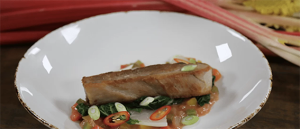
This dish takes rhubarb back to its original birthplace, earliest known records date back to 2700BC in China where it was cultivated for its medicinal purposes. Replacing the tomatoes in the sweet and sour sauce with rhubarb brings its own sourness to the dish without the need of using as much vinegar as a classic recipe. This dish could be used on a gastro pub menu as a main course or even a smaller version as a starter.
Serves 4
Prep & Cooking time 45 mins
- 800g pork belly, bone out and skin off
- 200g rhubarb
- 1 red pepper
- 1 yellow pepper
- 1 green pepper
- 1 medium white onion
- 2 pak choi
- 2 spring onions finely sliced
- 50g caster sugar
- 20ml rice wine vinegar
- 20ml mirin
- 1 tbsp cornflour
- 20g grated fresh root ginger
- Salt
- Plain flour for dusting
1. Pork belly: Firstly you need to cook the pork belly, salt it heavily and place it in a vacuum bag and vacuum on full, place in a preheated water bath at 82 degrees for 12 hours, once done submerge in iced water until cool and press under something heavy in the fridge. Alternatively, you can confit or braise the pork belly, you would need to salt it for around 2 hours beforehand so that the seasoning doesn’t come off during the cooking process.
2. Rhubarb sweet and sour: Chop up the rhubarb and combine in a medium saucepan with the ginger, vinegar, mirin and sugar. Cook on a low heat until the rhubarb starts to break down and release its juices, if it doesn’t release enough and looks a bit dry, add a small amount of water. Cook out until the rhubarb has completely fallen apart, blend in a liquidiser until smooth and add back to the pan once you have cleaned it out. Bring to the boil slowly, combine the cornflour with a small amount of water until you have a smooth paste and whisk into the sauce, this should thicken it slightly and give it a Chinese sweet and sour consistency cook out for a couple of minutes and take off the heat.
To serve
1. Slice the pork belly lengthways into suitably sized portions, dust in flour and tap off excess, fry on each side in a medium frying pan until golden and crispy on each side, if you have cut thick portions you may need to transfer the pork belly into an oven to heat through.
2. Cut the peppers and onion into small dice (although any dice is fine depending on how you want it) quickly fry in a frying pan with a small amount of oil, do not overcook you still want the peppers to be half raw to keep the crunch in them) add the sweet and sour sauce and completely combine, spoon onto the plate.
3. Blanch the pak choi in salted water, drain on kitchen towel and season, place on top of the sweet and sour sauce, place the pork belly on top of it all and garnish with spring onions and chilli’s




